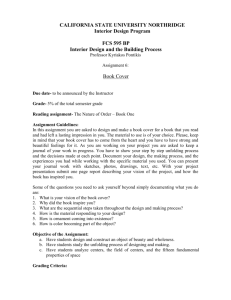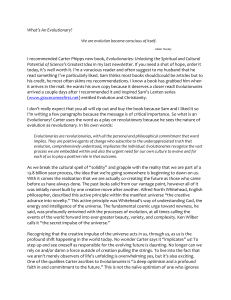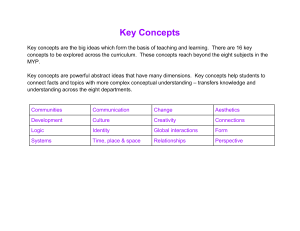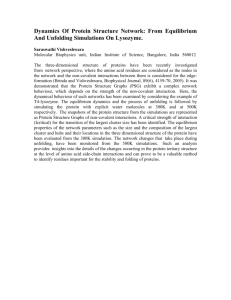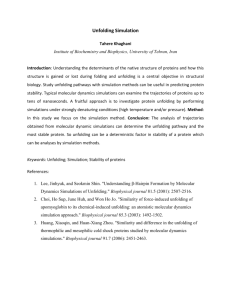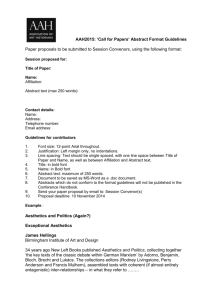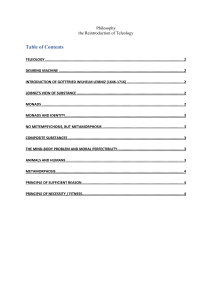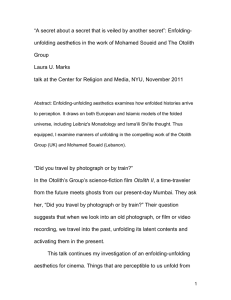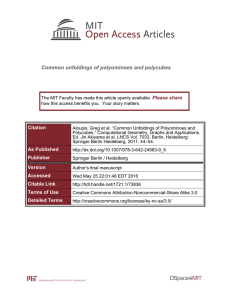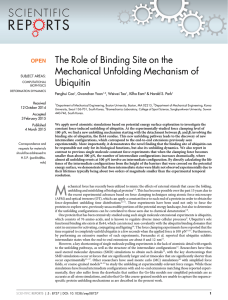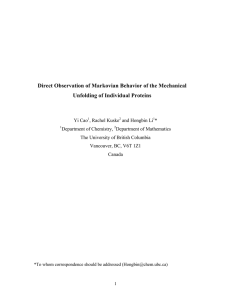Document 10574738
advertisement
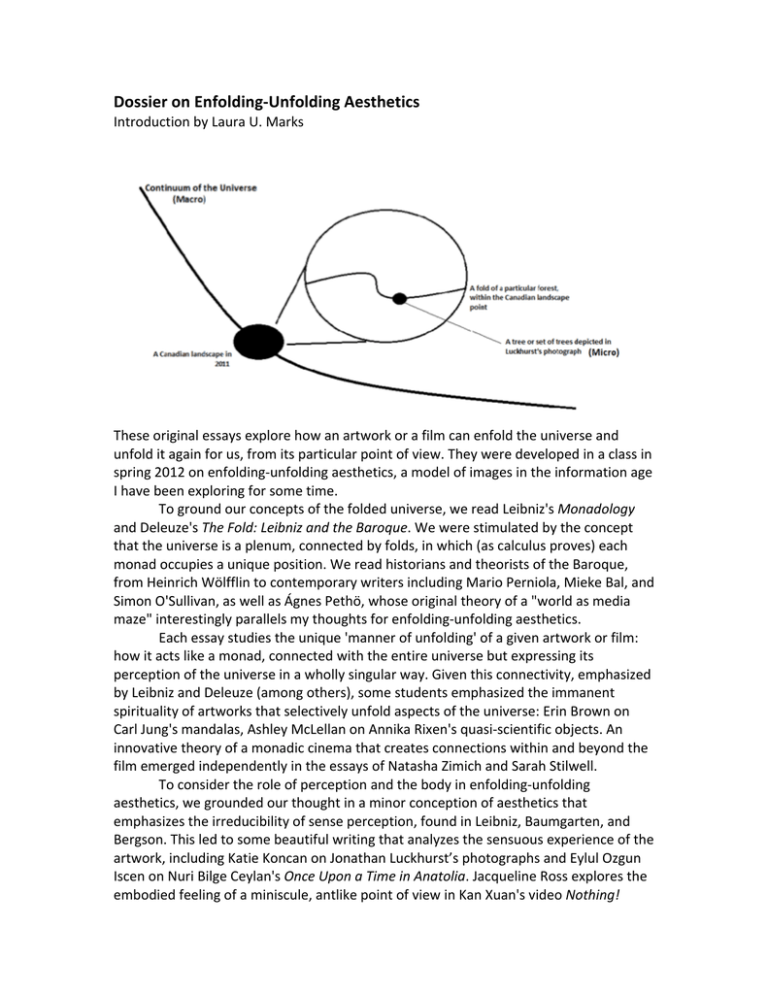
Dossier on Enfolding-­‐Unfolding Aesthetics Introduction by Laura U. Marks These original essays explore how an artwork or a film can enfold the universe and unfold it again for us, from its particular point of view. They were developed in a class in spring 2012 on enfolding-­‐unfolding aesthetics, a model of images in the information age I have been exploring for some time. To ground our concepts of the folded universe, we read Leibniz's Monadology and Deleuze's The Fold: Leibniz and the Baroque. We were stimulated by the concept that the universe is a plenum, connected by folds, in which (as calculus proves) each monad occupies a unique position. We read historians and theorists of the Baroque, from Heinrich Wölfflin to contemporary writers including Mario Perniola, Mieke Bal, and Simon O'Sullivan, as well as Ágnes Pethö, whose original theory of a "world as media maze" interestingly parallels my thoughts for enfolding-­‐unfolding aesthetics. Each essay studies the unique 'manner of unfolding' of a given artwork or film: how it acts like a monad, connected with the entire universe but expressing its perception of the universe in a wholly singular way. Given this connectivity, emphasized by Leibniz and Deleuze (among others), some students emphasized the immanent spirituality of artworks that selectively unfold aspects of the universe: Erin Brown on Carl Jung's mandalas, Ashley McLellan on Annika Rixen's quasi-­‐scientific objects. An innovative theory of a monadic cinema that creates connections within and beyond the film emerged independently in the essays of Natasha Zimich and Sarah Stilwell. To consider the role of perception and the body in enfolding-­‐unfolding aesthetics, we grounded our thought in a minor conception of aesthetics that emphasizes the irreducibility of sense perception, found in Leibniz, Baumgarten, and Bergson. This led to some beautiful writing that analyzes the sensuous experience of the artwork, including Katie Koncan on Jonathan Luckhurst’s photographs and Eylul Ozgun Iscen on Nuri Bilge Ceylan's Once Upon a Time in Anatolia. Jacqueline Ross explores the embodied feeling of a miniscule, antlike point of view in Kan Xuan's video Nothing! Artworks do not only unfold the universe; they also maintain an elastic tension between what can be drawn out and what remains enfolded. Jerina Hajno demonstrates this tension in Sarah Morris' city films. Iscen argues that Ceylan's film presents history, both regional and personal, as an enigma (cf. Perniola) in which the same image enfolds diverse, even incompatible experiences. We were struck by the ethical dilemma of Leibniz's 'dominated monad,' slaving for us human macro-­‐monads under the yoke of the vinculum: this arose especially in Tyler Fox's study of the Tissue Culture and Art Project, and also Brown's essay on Jung's mandalas. Yet we found that a theory of the monad need not be anthropocentric: Yi Xin Tong explored how trees are also monads expressing their perception of the universe in an examination of Christoph Runné's film installation Baum. We considered whether information or quantification might comprise another layer of folds, and whether a work that unfolds from information might still be singular, reading work by Gilbert Simondon, Peter Galison, Ted Byfield, Sha Xin-­‐wei, and me. Some students explored the degree to which artworks that emerge from quantification may still be singular: Laura Weber on Malcolm Levy's digital videos, Hajno on Morris' city films, and Stacey Leung on Emmett Williams' treatment of Gertrude Stein's concrete poetry. I am so grateful to all the students in "Enfolding-­‐Unfolding Aesthetics" for not only humoring my theory in process (they had no choice!) but courageously questioning, testing, and developing it in new directions. Their generosity extended to wonderful exercises in diagrammatic thinking, a Deleuzian practice that I have taken up and passed on. All essays are copyright of the authors. You may reproduce and distribute them with proper credit. Contents: Erin Brown, "Leibniz, Deleuze, and the 'Red Book" Mandalas of C.G. Jung" Tyler Fox, "Metastable Care: Considering Semi-­‐Living Monads in BioArt" Jerina Hajno, "Creased Surface, Open City: Baroque Aesthetics and Withholding Resolution in Sarah Morris' City Films" Ozgun Eylul Iscen, "Once Upon a Time in Anatolia: The Enfolding-­‐Unfolding Aesthetics of a Film" Katie Koncan, "The One in the Many and the Many in the One: An Analysis of Monads, Folds, and the New Harmony in Jonathan Luckhurst's 'Monuments' Exhibition" Stacey Leung, "Language as Information and Screen" (on Emmett Williams' 13 Variations) Ashley McLellan, Spirituality Persists: Unfolding an Immanent Spirituality in Annika Rixen’s Sciences of Observation Jacqueline Ross, "Reversible Terrain: Point of View in Kan Xuan's Nothing!" Sarah Stilwell, "Andrei Tarkovsky's Stalker: Matter, soul and folded surfaces" Yi Xin Tong, "Life of Im/mobility" (on Baum by Christoph Runné) Laura Weber, "The image of information in Malcolm Levy’s video art: the digital plane of immanence and the unfolding of an Other world" Natasha Zimich, "Feminine Manners of Unfolding in Horror Cinema: Unpacking Karen Lam’s Short Film Doll Parts" Copyright held by authors. All rights reserved. Diagrams by Katie Koncan and Erin Brown. Papers from Art & Culture Studies Summer 2012
